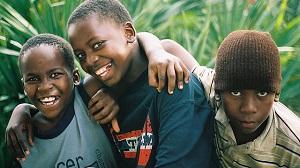New study of the ancestry of African Americans sheds fresh light on the story of slavery
Release Date 05 May 2017

The ancestry of African Americans has been traced back 5000 years to sub-Saharan Africa according to a new paper published in Science.
Through extensive analysis carried out on more than 2000 samples of individuals from 57 populations throughout sub-Saharan Africa, scientists from an international consortium including the University of Reading and led by the Institut Pasteur and the CNRS, were able to trace the migration path of these populations over five millennia.
Dr Rebecca Grollemund, a linguist who worked on the paper at the University of Reading said:
“The study reconstructed the genetic history of Bantu-speaking communities, from their initial expansions within Africa to the most recent forced migrations of a subset of these populations to North America, and our hope is that through further study, we will be able to better understand the complex genetic history of African and African Americans.”
“Our latest research provides a compelling picture of the ancestry of many of the 45 million African Americans now living across the US alone. Around three quarters of all African ancestry in the US can be traced back to the 23% of slaves from western central Africa transported to North America between 1619 and 1860, so the latest findings really do shed new light for millions of African Americans.
As a result of expansionary movement initiated between 4000 and 5000 years ago, the consortium believe that the Bantu-speaking populations - now 310 million people - gradually left their original home in West Central Africa to reach the regions Eastern and southern parts of the continent.
The paper found that such migration had profound consequences on the genetic history of the Bantus and contributes to one of the most painful periods in the history of Africa: the transatlantic slave trade.
With the genome of today's African Americans living on the North American continent is 75-80% African, the paper looked at more accurately tracing the genetic origin of this part of their genome by comparing that of nearly 5,000 African Americans from all the United States with that of African populations currently living in the former large slave ports.
The findings show that nearly 50% of the genome of African-Americans came from the port historically called "Gulf of Benin". The other major contribution, almost 30%, comes from West Central Africa (Gabon, Angola), highlighting the heavy toll paid by these populations to the slave trade. Finally, 13% come from the former port of Senegambia (basin of the rivers Senegal and Gambia) and 7% of the Coast of the Gold (Gulf of Guinea).
Full report:
Etienne Patin, Marie Lopez, Rebecca Grollemund, Paul Verdu, Christine Harmant, Hélène Quach, Guillaume Laval, George H. Perry, Luis B. Barreiro, Alain Froment, Evelyne Heyer, Achille Massougbodji, Cesar Fortes-Lima, Florence Migot-Nabias, Gil Bellis, Jean-Michel Dugoujon, Joana B. Pereira, Verónica Fernandes, Luisa Pereira, Lolke Van der Veen, Patrick Mouguiama-Daouda, Carlos D. Bustamante, Jean-Marie Hombert, Lluís Quintana-Murci (2017), Dispersals and genetic adaptation of Bantu-speaking populations in Africa and North America http://dx.doi.org/10.1126/science.aal1988
Copyright: Children of Bantu refugees, Melvin "Buddy" Baker, 2007. Available at https://www.flickr.com/photos/58034970@N00/372834515/ CC 2.0